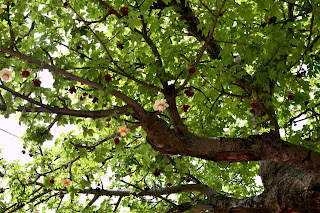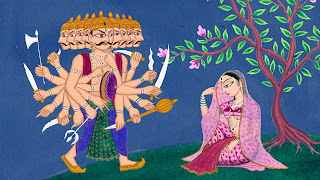Week 12 Lab: Storybook Research
Kamadeva Shooting Arrows at Shiva
Image Link
Ashoka Tree and Kamadeva
Sacred Trees and Plants in Hinduism, Richa Sharma, Source
- Ashoka is a legendary and sacred tree in India,
- fascinating flower essence; very fragrant, bright orange-yellow flowers, which later turn red; delicately perfumed flowers are used in temple decoration
- very handsome, small, evergreen tree, with deep green foliage and
- Ashoka can mean without grief or that which gives no grief
- the tree of love blossoms; a symbol of love
- dedicated to Kamadeva, God of Love; he cannot be destroyed by demons or gods and permeates the entire cosmos
A Brief Guide to The Sacred Trees of India, Jyoti Jennings Roth, Source
- Ashoka: A Guard Against Grief
- water in which the Ashoka flowers have been washed is used as a protective and healing draught against sorrow
- also associated with fertility; the bark of the tree is used as a remedy for reproductive disorders and to restore fertility.
Wikipedia, Source
- the Ashoka tree is worshipped in Chaitra, the first month of the Hindu calendar (associated with the beginning of the universe creation and the season spring). It is
- also associated with Kamadeva (son of Vishnu or Brahma), who included an Ashoka blossom among the five flowers in his quiver,
- Ashoka represent seductive hypnosis
- Kamadeva is married to Rati
- the Ashoka tree is mentioned in classical Indian amorous poetry
- Kamadeva is often depicted with green (or sometimes reddish) skin with a bow made of sugarcane and arrows made of flowers; rides a parrot and may be accompanied by the god of spring, hummingbirds and Rati
Kamadeva (God of Desire), Hrodrigues, Source
- in depictions of Kamadeva is his wife Rati– the personification of sexual delight
- Rati possesses beauty that is able to distract even the sages; carries a discus and lotus; Kamadeva’s assistant, who she was mutually in love with upon meeting.
- Rati enthralls others with desire and satisfies Kamadeva's own sexual needs but does not take on any other wifely duties
- Kamadeva has three voluptuous daughters described as temptresses
- Kamadeva’s most significant role is characterized as Shiva’s sexual opponent
- Shiva must refrain from desire as an ascetic; as the god of the linga and Parvati's husband Shiva must produce offspring
- Kamadeva momentarily meets his demise after interrupting Siva’s meditations; is burned by Shiva's third eye
- Brahma and Indra asked Kamadeva to fill Shiva with desire so that he will create an offspring with Parvati
- with Rati and the spring season on his side, Kamadeva goes to the place where Shiva is in deep meditation; is first confronted by the guard Sailadi but disguises himself as a sweet-scented breeze to pass by
- it's disputed who Shiva saw first, Kamadeva or Parvati, but either way Shiva incinerates Kamadeva and has a child with Parvati
- Parvati was upset that Shiva burned Kamadeva, believing happiness was impossible without him around; Kali asked Shiva to bring him back so Kamadeva was returned in a bodiless form
- it was important for Shiva and Parvati to have a child because only that child could defeat the demon Taraka
- Legend says after Shiva incinerated Kamadeva in anger for breaking his meditation, love was removed from the world; was only restored once Shiva reincarnated Kamadeva in the bodiless form
- Another rumor says Kamadeva was reincarnated as Krishna's son Pradyumna after Shiva incinerated him.
- other theories around why Krishna and Kamadeva look and act in similar ways; Krishna's consort Radha is so beautiful she can defeat Kamadeva's powers




Comments
Post a Comment